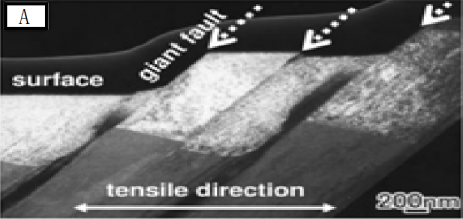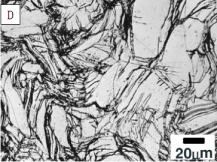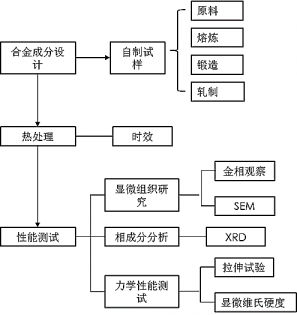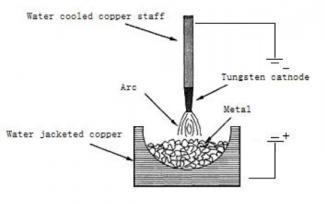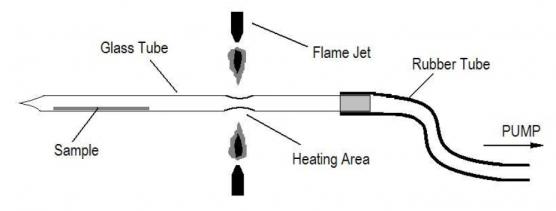论文总字数:33511字
摘 要
钛合金因其优异的综合性能被广泛应用于航空工业。随着科技的发展,航空工业对钛合金的高强度低弹性模量特性提出了更高的要求。本文根据钛合金成分设计理论设计出一系列Ti-Nb-Zr-Mo-O合金,系统地研究了锆、氧含量对于Ti-Nb-Zr-Mo-O合金棒材以及时效温度及时间对于Ti-32Nb-4Zr-2.8Mo-0.3O合金棒材的显微组织及力学性能影响。
Ti-32Nb-(0,2,4,6)Zr-2.8Mo-0.3O合金经固溶处理(1000℃,1h)和冷变形后主要为β相,含有少量α’’相。随着Zr含量的增加,抗拉强度略有下降,合金硬度和延伸率呈现出先降低后升高的趋势,弹性模量在49~55GPa之间。合金的XRD图谱表明合金在轧制过程中发生了应力诱发马氏体转变, Zr含量的增加抑制了α’’相的形成,使合金晶粒细化,起到了增强β相稳定性的作用。
Ti-32Nb-(2,4)Zr-2.8Mo-(0,0.15,0.3,0.45)O合金经固溶处理和冷变形后主要为β相,同时含有少量α’’相。 随着氧含量的增加,合金的强度提高,硬度增加,弹性模量均在55GPa以下,从断口形貌可以看出,断裂方式由韧性断裂向脆性断裂转变,延伸率下降。XRD图谱表明氧元素具有一定的抑制α”相形成的作用。当氧含量为0.3%时,Ti-32Nb-4Zr-2.8Mo-0.3O合金的抗拉强度达到1090MPa,弹性模量为50.8GPa,延伸率为12.5%。
随着时效温度的升高,Ti-32Nb-4Zr-2.8Mo-0.3O合金在短时时效后弹性极限略有上升,抗拉强度及延伸率变化不大,弹性模量维持在50GPa左右。从XRD衍射图谱中可以看出,时效后的合金组织均为β相。经过300℃时效30min后,Ti-32Nb-4Zr-2.8Mo-0.3O合金的抗拉强度可达1118MPa,弹性模量仅为47.9GPa,具有良好的综合力学性能。
关键词: Ti-Nb-Zr-Mo-O合金;高强度;低弹性模量;时效;钛合金
Research on Microstructure and Mechanical Properties of New Type Titanium Alloy with High Strength and Low Elastic Modulus Used for Aircraft Parts
Abstract
Titanium alloys are widely used in aviation industry due to the excellent comprehensive properties. With the development of science and technology, aviation industry puts forward a higher requirement of properties of high strength and low elastic modulus for titanium alloys. In this paper, a series of Ti-Nb-Zr-Mo-O alloys has been designed to investigate the influence of the content of Zr and O and the temperature and time in heat treatment on the microstructure and mechanical properties of Ti-Nb-Zr-Mo-O and Ti-32Nb-4Zr-2.8Mo-0.3O(w.t%) alloys respectively.
The Ti-32Nb-(0,2,4,6)Zr-2.8Mo-0.3O alloys are mostly composed of single β phase with a little α” phase after solution treatment (1000℃) for 1h and cold working (90%). With the increase of content of Zr, the tensile strength decreases a little while the Vickers hardness and elongation decrease at first and then they increase. The elastic modulus remain comparatively low (49-55GPa). The XRD spectrum shows that stress induced martensitic transformation happened in the process of rolling. The increase of Zr content can inhibit the formation of α’’ phase in Ti-32Nb-(0,2,4,6)Zr-2.8Mo-0.3O(w.t%) alloys, and refines the crystalline structure. Zr plays the role of beta phase stable elements in titanium alloys.
The Ti-32Nb-(2,4)Zr-2.8Mo-(0,0.15,0.3,0.45)O(w.t%) alloys are also mostly composed of single β phase with a little α” phase after solution treatment (1000℃) for 1h and cold working (90%). With the increase of O element, the tensile strength and Vickers hardness increase a lot while elongation decreases and the elastic modulus are always under 55GPa. At the same time, the fracture mode changed from ductile fracture to brittle fracture which can be seen from the fracture morphology. The XRD spectrum shows that the increase of O content can inhibit the formation of α’’ phase. Ti-32Nb-4Zr-2.8Mo-0.3O(w.t%) alloys exhibit outstanding comprehensive mechanical properties: the tensile strength and elongation achieve 1090MPa and 12.5% respectively. But the elastic modulus are only 50.8GPa.
With the increase of heat treatment temperature, the elastic limit strength of Ti-32Nb-4Zr-2.8Mo-0.3O(w.t%) alloys increases a little. At the same time, the tensile strength and elongation has no change while the elastic modulus remain at around 50GPa. The XRD spectrum shows that there is only beta phase in the alloys after heat treatment. After heat treatment(350℃) for 30min, Ti-32Nb-4Zr-2.8Mo-0.3O(w.t%) alloys exhibit outstanding comprehensive mechanical properties: the tensile strength achieve 1118MPa and the elastic modulus are only 47.9GPa.
Key words: Ti-Nb-Zr-Mo-O alloys; high strength; low elastic modulus ; heat treatment; titanium alloys
目录
摘要 I
Abstract II
第一章 绪论 1
1.1 引言 1
1.2 钛及其合金的发展 1
1.3 航空用钛合金 2
1.3.1 高温钛合金 3
1.3.2 高强钛合金 3
1.4 钛合金设计原则 3
1.5 橡胶金属 5
1.6 选题背景及主要研究内容 8
参考文献 8
第二章 合金制备及测试方法 10
2.1 引言 10
2.2 试验材料及设备 11
2.2.1 试验材料 11
2.2.2 试验设备 11
2.3 钛合金设计原则 12
2.4 合金试样制备方法 13
2.4.1 合金熔炼 13
2.4.2 锻造与车削 13
2.4.3 固溶处理 13
2.4.4 冷变形加工 14
2.4.5 时效 14
2.5 合金性能测试方法 14
2.5.1 室温拉伸试验 14
2.5.2 维氏显微硬度 15
2.5.3 金相组织分析 16
2.5.4 SEM断口分析 16
2.5.5 XRD分析 16
2.5.6 热膨胀 16
参考文献 16
第三章 合金元素对Ti-32Nb-xZr-2.8Mo-yO合金组织及性能的影响 17
3.1 引言 17
3.2 锆元素对Ti-32Nb-xZr-2.8Mo-0.3O合金组织性能影响 17
3.2.1 金相组织和相结构 17
3.2.2 力学性能 19
3.2.3 断口形貌分析 21
3.3 氧元素对Ti-32Nb-(2,4)Zr-2.8Mo-yO合金组织性能影响 21
3.3.1 金相组织和相结构 22
3.3.2 力学性能 25
3.3.3 断口形貌分析 27
3.4 本章小结 28
参考文献 28
第四章 热处理对Ti-32Nb-4Zr-2.8Mo-0.3O合金组织及性能的影响 30
4.1 引言 30
4.2 热膨胀及热处理方案 30
4.3 金相组织与相结构 31
4.4 力学性能 33
4.5 本章小结 35
参考文献 35
第五章 结论 36
致谢 37
第一章 绪论
1.1 引言
航空航天行业在现代社会中占据了非常重要的地位。由于钛合金具有高比强度、较强的抗腐蚀能力以及比较大的工作温度区间,在航空航天行业应用十分广泛。近年来,军用和民用飞机中含钛量均有逐渐提高的趋势,美国军用战斗机F22中钛合金用量高达39%到41%,而空客公司最新的大飞机A380中钛合金用量也达到了10%左右。钛及其合金在飞机上的应用包括结构零件、承力构件、板材冲压件以及航空发动机里的涡轮叶片、机盘等多种部件,而世界范围内航空钛加工材需求占钛材总需求量的50%左右[1]。随着科技发展,航空工业对于材料的要求越来越高,研究具备高强低弹性能的钛合金对于促进航空工业的发展有着重要的意义。
1.2 钛及其合金的发展
钛,英文名为Titanium,在地壳中储量占据所有元素的第九位。钛最早在1791年被发现,但是直到1948年,钛的工业化生产才真正拉开了序幕。
钛呈银白色,在化学元素周期表中位于第4周期、第IVB族。钛的熔点为1668℃,在室温下呈密排六方的α相,升温到882℃时产生同素异构转变,由α-Ti变为体心立方的β-Ti。钛的比强度高,抗腐蚀能力很强,同时钛还具有诸如热膨胀系数低、低温性能好、耐生物侵蚀等优良性质,在航空航天以及生物医学、能源等方面有着非常广泛的应用。
随着科技的发展,各种各样具备优异性能的钛合金进入了各行各业当中。根据组织分类,钛合金可分为α、α β以及β钛合金。α钛合金,其强度、韧性和焊接性很好,但是α钛合金锻造性不良,在锻造时容易产生缺陷,对α钛合金的性能产生很大影响。为了改善α钛合金的性能,在工业生产时,通常通过减少压缩率和多次重新加热的方法来减少α钛合金的锻造缺陷。α钛合金还具有另外一个特点,它不能通过热处理对其性能进行强化,因此α钛合金只在退火和再结晶状态下使用。 α β两相钛合金拥有较好的综合性能,同时通过热处理可以改善其性能。α β两相钛合金的成分支持α β相混合物存在,对其进行固溶处理,再进行480—650 ℃时效后,残余的或已转变的β相基体上有细小α相析出,形成细小的α β两相混合物。β钛合金中常含有过渡元素,如钒Va、铌Nb和钼Mo。 在钛合金中,这些过渡元素属于β相稳定元素,起到降低β相转变温度的作用,从而使得bcc结构的β相能够在室温下形成。相比于α钛合金,β钛合金在一个较广的温度范围内具有优良的锻造性。同时,β钛合金具备优良的淬硬性,且β和近β钛合金相比于α β钛合金在同等强度水平上具有更高的断裂韧性,能够满足航空结构件的性能要求,因此,β钛合金常常被用来作为航空结构材料和制造承载部件。表1-1中列出了部分α、α β以及β钛合金的力学性能。
表1-1 部分α、α β以及β钛合金的力学性能[2] | ||||||
合金 | 抗拉强度/MPa | 屈服强度/MPa | 延伸率/% | 断面收缩率/% | 弹性模量/GPa | 类型 |
纯钛(1级) | 240 | 170 | 24 | 30 | 102.7 | α |
纯钛(2级) | 345 | 275 | 20 | 30 | 102.7 | α |
纯钛(3级) | 450 | 380 | 18 | 30 | 103.4 | α |
纯钛(4级) | 550 | 485 | 15 | 25 | 104.1 | α |
Ti-6Al-4V(退火) | 895~930 | 825~869 | 6~10 | 20~25 | 110~114 | α β |
Ti-6Al-7Nb | 900~1050 | 880~950 | 8.1~15 | 25~45 | 114 | α β |
Ti-5Al-1.5B | 925~1080 | 820~930 | 15~17 | 36~45 | 110 | α β |
Ti-12Mo-6Zr-2Fe(退火) | 1060~1100 | 1000~1060 | 18~22 | 64~73 | 74~85 | β |
Ti-15Mo(退火) | 874 | 544 | 21 | 82 | 78 | β |
Ti-15Mo-5Zr-3Al(固溶) | 852 | 838 | 25 | 48 | 80 | β |
Ti-15Mo-5Zr-3Al(时效) | 1060~1100 | 1000~1060 | 18~22 | 64~73 | 80 | β |
Ti-15Mo-2.8Nb-0.2Si(退火) | 979~999 | 945~987 | 16~18 | 60 | 83 | β |
1.3 航空用钛合金
世界范围内航空钛加工材需求占钛材总需求量的50%左右[1],航空工业在目前的钛合金市场中占据第一的位置,航空钛合金的研究、应用和发展对于世界钛合金工业的影响是举足轻重的。
航空钛合金根据其应用方向主要分为两个大的方面:飞机机体用钛合金以及航空发动机用钛合金。根据抗拉强度,飞机机体用钛合金又可分为低强度钛合金、中强度钛合金、高强度钛合金和超高强度钛合金四类[3](见表1-2),主要用来制造飞机的壳体、蒙皮以及承力结构件和紧固件等。航空发动机用钛合金是指具有较高的高温蠕变抗力、持久强度、高温强度、热稳定性和高温疲劳等性能,能够满足航空发动机零件在高温环境下长期工作要求的钛合金,主要用于制造航空发动机压气机叶片、轮盘和机匣等零件[3]。
表1-2 飞机机体用钛合金由抗拉强度分类[3] | |||||
类别 | 低强度钛合金 | 中强度钛合金 | 高强度钛合金 | 超高强度钛合金 | |
抗拉强度 | ≤700MPa | 700~1000MPa | 1000~1250MPa | ≥1250MPa | |
主要牌号 | TA1、TA2、TA3、TA16,TA18、TA21、TC1、TC2 | TC4、TA15、TC6、TC4-DT | TB2、TB3、TB5、TB6、TB8、TC16、TC18、TC21 | TB8、TB-19 | |
根据强度和服役条件,航空钛合金又可以被分成高温钛合金、高强钛合金、损伤容限型钛合金和阻燃钛合金等[1]。此处仅对高温钛合金和高强钛合金进行较为具体的介绍。
1.3.1 高温钛合金
高温钛合金是指在某一温度限之下能够长时间使用的钛合金。高温钛合金主要是用于航空发动机上,代替钢或者高温合金,制造压气机和风扇的盘件、叶片和机匣等零件,从而起到降低发动机的重量的作用。
剩余内容已隐藏,请支付后下载全文,论文总字数:33511字
相关图片展示:
该课题毕业论文、开题报告、外文翻译、程序设计、图纸设计等资料可联系客服协助查找;

